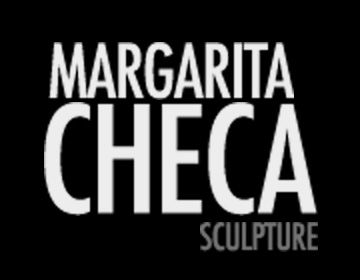MARGARITA CHECA
ART CRITIC
By Elida Roman
With “The Web of Life” (Lucia de la Puente Art Gallery), Margarita Checa keeps on populating her world of symbolic creatures. Women, children, and teenagers, so real, and yet, so filled with introspective messages and eloquent gestures.
In the introduction to the exhibition, the artist verbalizes the intention as follows: “The earth does not belong to men, it’s men who belong to the earth. Everything is connected, like the blood that bonds us all. Men did not weave the web of life; it is only the thread of it. What he does to the web, he does to himself.” Vocation for emphasize that already traced destiny and the unavoidable solidarity that human condition requires. How to materialize this concept? How to suggest these terms of origin and destiny? Checa has chosen two powerful images: woman and child.
And she recreates them in erect, lean and austere figures, with an air where mystic and exotic fuse together through the complicity of the enriching inlays; where the used materials play a role not only of artistic dialogue, but also of symbolic facilitation. The warmth of native woods (olive, huiruro, cachimbo colorado, yacushapana) is intervened by bullhorn inlays, Huamanga stone and metals such as silver and bronze, guards with ornaments, details, and complementary objects that succeed to daze for their precise inclusion. Real weaves – perhaps the web that the artist tries to show us -, included in the detailed, elegant and powerful forms, carriers of a fate that guides and obliges them. A common detail of most of the sculptures is the lack of hair, highlighting the clean skull, stripped. At most, a rich headdress (“Energy”, “The Thin Line”), both showing a naked torso and a fabric embracing the hips extending itself like a truncated tunic. The children, in poses that remind us of child’s play, the innocent attitude shows some gesture of movement in action. But it is “Logos” the work piece that impresses the most for its narrative quality, and at the same time, for its emotional expression. Two naked bodies embracing, one carrying the younger which is leaning its head on the shoulder of the other, laid, relieved or recumbent, inert, abandoned. The maternal protection, or the guide grows – understanding and loving -, or the compassionate aid. Ambiguity of the circumstance and touching embrace.
A set of small sculptures in bronze repeats the pointed forms. In these sculptures the result is diverse, maybe due to the materials used and the technical demands required. In spite of the good execution, they don’t achieve the immediate dialogue that the sculptures in wood do. The exhibition is a gallery of characters that keep populating the personal world of a remarkable sculptress – of meticulous and careful work -, who has achieved to create and elaborate a poetic exhibition through sculptures that always encompass a mysterious and untroubled message, like a guardian of a secret enigma yet to be discovered.
